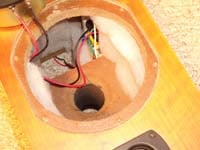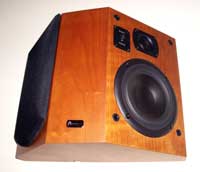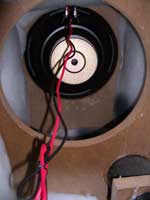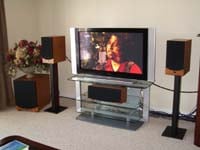Aperion Audio Intimus 632-LR Loudspeaker Review
- Product Name: Intimus 632-LR
- Manufacturer: Aperion Audio
- Performance Rating:




- Value Rating:




- Review Date: January 09, 2006 19:00
- MSRP: $ 1967
632-LR - $299 ea.
Type: 2-way vented
enclosure; 1" HDF
Woofer: 6.5" long-throw
composite
Tweeter: 1" silk dome
Frequency
Response: 46Hz - 20kHz (+/- 3dB)
Nominal Impedance:
8-ohms
Crossover: HD-X^3
Sensitivity:
86dB
Recommended Power: 50-200 Watts RMS
Magnetic
Shielding: Yes
Dimensions: 15" H x 7-7/8" W x
12-3/4" D
Weight: 26 lbs
533-VAC - $280
Type: Passive radiator;
1" HDF
Mid-Woofer: 5.25" Poly Vinyl Acetate (PVA) damped
paper
Midrange: 4" Custom Poly
paper
Tweeter: 1" silk dome
Frequency
Response: 80Hz - 20kHz (+/- 3dB)
Nominal Impedance:
8-ohms
Crossover: HD-X^3
Sensitivity:
88dB
Recommended Power: 50-150 Watts RMS
Magnetic
Shielding: Yes
Dimensions: 7-1/3" H x19" W x 8"
D
Weight: 20 lbs
534-SS - $245 ea.
Type: Sealed;
1" HDF
Woofer: Two 5.25" Poly Vinyl Acetate (PVA) damped
paper
Tweeter: Two 1" silk dome
Frequency
Response (dp): 60Hz - 14kHz (+/- 3dB)
Frequency Response
(bp): 90Hz - 8kHz (+/- 3dB)
Nominal Impedance:
12-ohms
Crossover: HD-X^3
Sensitivity:
NA
Recommended Power: 50-300 Watts RMS
Magnetic
Shielding: No
Dimensions: 10-5/8" H x 14-3/16" W x
6-3/4" D
Weight: 16 lbs
S-12 - $599
Type: Rear ported; 1" HDF
Woofer: 12"
Poly Vinyl Acetate (PVA) damped high-excursion paper
Output
power: 250 Watts RMS (400W peak)
Amplifier: Class
A/B
Crossover: Variable 40Hz -
160Hz
Phase: Variable 0-180 degrees
Speaker Level
Inputs: Yes
Frequency Response: 20Hz - 180Hz (+/-
6dB)
Dimensions: 20-1/2" H x 15" W x 21-1/2" D
Weight: 66 lbs
Pros
- Excellent build quality and components
- Prices include FREE UPS Ground shipping to contiguous 48 states
- Free in-home audition (includes free shipping both ways)
- 10-year warranty
- 1 year full price trade-up program
Cons
- Some mid-bass dips
- Limited frequency response on surrounds
Aperion Intimus 632-LR Build Quality
We've been big fans of several direct-to-consumer loudspeaker manufacturers - but only after they proved to us that their products held up against comparable models by more mainstream manufacturers. Last year Aperion Audio joined our recommended list by producing a good bang-for-the-buck product with the Intimus 5.1 system (comprised of four 532-LRs a 532-C and S-8 powered subwoofer). This year we wanted to hear what their newer, larger products had to offer in terms of quality and performance.
Build Quality & Features
While not an upgrade, but rather a different model, we want you to get an idea of the size of the new Intimus 632-LR loudspeakers by comparing them to the 532-LRs. Though they look similar from a distance, at over double the weight of the 532-LRs, the 632 series bookshelf speakers might just bend some particle board shelving at 26 lbs. They are 4.5" taller, about a 1/2" wider and provide over 50% more depth. In terms of volume, you're looking at an increase of 222%! Where the 532-LRs have a custom PVA-coated 5.25" midrange, the 632-LRs sport a custom designed 6.5" long-throw paper composite woofer. The bad news is that you will have to be very careful if you are choosing a mounting method - they're simply too heavy for anything but a rugged stud-anchored or shelf-type system. Of course we prefer speaker stands.
In case you thought Aperion was contemplating saving some money by cutting back on build quality - you'd be mistaken. Their entire loudspeaker line still utilizes the same 1" thick HDF cabinetry Aperion is famous for. Knock on the walls of these speakers and you may hurt your hand, but you won't hear any cabinet resonance. We removed one of the 6.5" midrange drivers and peered inside to see the well-braced, well-damped cabinet (ok, we admit it - we were looking for particle board or a reduction in the wall thickness!) While it is certainly impressive to see a 1" thick baffle, we have to say that it's really overkill for a cabinet of this size provided there is also some cross bracing (and there is). What ends up happening is the consumer simply pays more for the additional manufacturing and shipping costs with very little to no practical gains in sound quality. Ok, now that you've heard Audioholics criticize a company for having too good of quality in their products you can rest assured that you've probably seen everything.
The new 534-SS Dipole/Bipole surround speakers were much larger than I thought they would be. They sport dual 1" silk dome tweeters and 5.25" midrange drivers. The enclosures are designed to be flush-mounted to either side walls or, if need be, on the back wall as rear surrounds. They have a dipole/bipole switch that alters whether the drivers fire in-phase (bipole) or out of phase (dipole). With exception, the intended use is:
- Dipole: the default setting for creating a diffuse surround field desirable for home theater use
- Bipole: use for direct-radiating needs such as multi-channel music or in certain rear surround scenarios where placing the surrounds on the side wall is impossible and a less diffused sound is preferred.
In Reference System 3 I first configured the speakers on the back wall in Dipole mode for home theater, but switched them to Bipole mode when listening to multi-channel music. I tested both configurations for each use and finally determined that with my particular room configuration (rear-mounted surrounds above ear level) Bipole mode actually sounded better in almost all circumstances. It wasn't that the Dipole mode sounded wrong, but it was almost too diffuse and even approximate localization was difficult. Your room, of course may bring different results (and almost certainly will if you are mounting them on side walls, which is best). In either case be sure to mount the speakers correctly (they are labeled right/left) so that the out of phase drivers are located on the outside when in Dipole mode.
The 66 pound S-12 features a 12" PVA-coated front-firing paper driver powered by a 250 watt (400 watt peak) class A/B amplifier. The high excursion driver has a stamped steel frame and a butyl rubber surround. This unit is rather large, measuring over 6500 cubic inches (or 3.8 cubic feet). The interior of the subwoofer was well-damped and had adequate bracing across the center of the structure. There was no effective flexing that was going to occur in this cabinet. The single rear-firing port was not tapered on either end, but did appear to be tuned specifically for the system.
Pulling out the plate amplifier I found a large power supply with plenty of capacitance along for the ride - guaranteeing that the S-12 was more than equipped to drive the spec'd 250 watts per channel. One additional thing I noted was the organization of the circuit boards on the S-12 - everything was well laid-out on the power supply and cabling was more than sufficient to ensure good quality transfer of both power and audio throughout the system.
Aperion Intimus 632-LR Setup and Listening Tests
Listening Tests
I took particular approaches in listening to the Aperion Audio system. The first approach was what I knew it would do well with: movie soundtracks. The second, was high quality multi-channel surround audio - in particular, some tracks from AIX Records' Sampler Disc (multi-channel DVD-Audio) which are recorded and mixed without any electronic compression, EQ, or reverb.
 Spider-Man 2
Spider-Man 2
This is an exceptional movie for hearing a full home theater system - from the mains, to the sub, to the surrounds. Chapter 22 got us started when Doctor Octavius robbed the bank using his newly acquired arms. During the intense battle sequence which followed, Doc Ock and Spider-Man scaled the side of a building and the deep, staccato sub sounds generated by the impact of the metal arms on the concrete structure was intense. With the level of sound coming from the system, I was almost surprised that Aunt May didn't get literally shaken off that building.
The pounding ensued as both hero and antagonist slammed against the building over and over. As the police opened fired on Octavius, both off-screen gunshots and their corresponding ricochets danced in the surrounds. Even the omnipresent ambient wind noise sounded very convincing.
In Chapter 42's transit car scene there was a section at the beginning where Spider-Man bent backwards to get under a low-flying tunnel. The effect went from the front speakers to the surrounds in a transitional "wipe" that flew the ambience over your head (it reminded me of the cavern entrance sequence in Star Wars Episode I's Pod Race). There was also a brief, but dramatic sub-harmonic hit that occurred as Doc Ock ripped the controls from the high speed train car. It was very low - and the S-12 took the opportunity to rattle my frame on the couch with it. Later, in Chapter 46, that same sub sweetener re-appeared when Doctor Octavius activated his fusion reactor. It was a super low sweep and the effect was as cool as it was startling. As the fusion reactor exploded, the S-12 started to shake the entire room (in a good way).
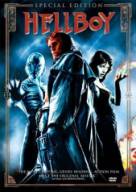 Hellboy
Hellboy
From the subwoofer and surround-sound rich opening credits, this film starts off using the entire Aperion Audio Intimus 6-Series. The S-12 accomplished two things very nicely: low, rumbly, powerful rolls, and smooth, tonal, low frequencies. Some subs succeed at one but lose control on the other.
In Chapter 7, when Hellboy performed his first on-screen mission there was very convincing use of the surrounds when the gunshots fired and the location of the creature he was hunting was off-screen. As the chase continued, it just got better. The following sword fight (if you can call it a "fight") had a nice crisp sound and motion was well-balanced within the sound stage. These speakers have an excellent ability to spatially represent what's happening on screen provided they are correctly placed and aligned.
Surrounds were once again hot and really accurate (spatially speaking) during a subsequent subway-based fight scene. I kept being very impressed by the immersive nature of the 534-SS surround speakers.
"Mosaic" from Laurence Juber's Guitar Noir Album (AIX 80018)
This is acoustic guitar at its best - plain and simple. The upright bass which was present on this track was smooth and clear. A shaker comes in about 30 seconds into the track and is nicely present in the mix - firmly placed in the surrounds without being distracting. In fact, they sounded as if they were not completely localized to one particular speaker, but within the room towards the right rear side. AT 1:45 there are ultra high metallic percussion bells which sprinkle across the soundstage. I doubt you would even hear these on a cubed system. As I played this track the only negative I could derive was that the center channel seemed a bit too localizable for my tastes. I have to admit, though - except for the slight vertical dip of the center channel tugging the soundstage downward it was like being in on the session.
"Moonlight Acoustica" by the AIX All Star Band (AIX80041)
A solid, driving kick drum marks the opening salvo of this track. The S-12 subwoofer sent the pressure of the kick drum across the floor and into the couch where I was listening. I could feel it in my chest as if I was there. There was what I perceived to be a slight de-emphasis of the mid-bass noticeable in this track, especially during one of the guitar solos. Soft snare rim hits filled the surrounds as did some rhythmic guitar fills and an organ.
"Nordenham" from The Carl Verheyen Band's Rumor Album (AIX83039)
This acoustic piece featured some very raw, well-played acoustic guitars and bass. Distinctive surround elements came through - again, without distraction or folding the front soundstage - even when utilizing multiple listening positions.
"Ocean" from Johnathan McEuen's One Step Ahead Album (AIX83029)
Firm, smooth bass and clean, clear vocals designate this recording as being an intricate recording that allowed me to hear a male voice with all of its detail and raw quality. The natural room reverb captured by the surrounds in this track are nothing short of amazing for a speaker package costing less than what many retail loudspeaker manufacturers charge for their center channels. Listen to the finger movement noises on the guitar and hear how the surrounds pick those up as part of the room reverb.
"The Hag at the Churn" from Bad Haggis' Span Album (AIX83029)
Bagpipes have never sounded this cool. We're talking harmonies set to a fast-paced Celtic rhythm. Toss in some raw vocal harmonies in the surrounds (the bagpipes are the front and center focus here), some center-anchored driving bass, and you have one excellent track that sounded refined and accurate on the Aperion system. A drum set was placed more directly in the surround off to your right and the effect was driving and "in your chest" solid.
 Seal IV
Seal IV
For some extra low frequencies and a voice I was even more intimately familiar with, I popped in some Seal and queued up "Get It Together". Seal brought back some of those lower mids which were lacking earlier. It also, however, demonstrated the insanely low frequencies the "bargain" S-12 was capable of as the song ran several musical sweep effects throughout the course of this track. Surrounds were supportive and filling, but not nearly as interesting (or the focus) as with the AIX Records tracks. This is simply the result of a different mixing process and methodology.
A softer song, "Love Devine", gave a less compressed and more open sound to listen to. The artificial reverb came through with clean decay, and the subtle but sturdy bass made sure its presence was felt. The fuller mix of this track, as it was in later verses, showed me that the 533-VAC center channel could maintain detail and clarity - even with a full and active 5.1 soundtrack playing through the system.
Aperion Intimus 632-LR Conclusion
The Aperion Audio 6-Series speakers are a marked upgrade from earlier models and bring Aperion to the point of having a completed range of speakers for almost every need. We enjoyed this system much more than even the 5-series and appreciated the flexibility they offered. In subsequent two channel listening tests I did note that compared to my RBH Sound 61-SE/R reference speakers, there was a bit missing from the midrange in terms of clarity and control - and vocals could tend to sound slightly chesty. Of course they cost more than twice as much as the Aperions. The new 534-SS Dipole/Bipole speakers are really impressive and it's nice to see the switchable polarity to make them even more useful in a variety of situations. Aperion Audio has come a long way and doesn't seem to be showing signs of slowing (in fact, they recently introduced a line in in-wall and in-ceiling products). These speakers don't necessarily perform way beyond their price range, but even so they may be hard to beat.
The Score Card
The scoring below is based on each piece of equipment doing the duty it is designed for. The numbers are weighed heavily with respect to the individual cost of each unit, thus giving a rating roughly equal to:
Performance × Price Factor/Value = Rating
Audioholics.com note: The ratings indicated below are based on subjective listening and objective testing of the product in question. The rating scale is based on performance/value ratio. If you notice better performing products in future reviews that have lower numbers in certain areas, be aware that the value factor is most likely the culprit. Other Audioholics reviewers may rate products solely based on performance, and each reviewer has his/her own system for ratings.
Audioholics Rating Scale




 — Excellent
— Excellent



 — Very Good
— Very Good


 — Good
— Good

 — Fair
— Fair
 — Poor
— Poor
| Metric | Rating |
|---|---|
| Build Quality | |
| Appearance | |
| Treble Extension | |
| Treble Smoothness | |
| Midrange Accuracy | |
| Bass Extension | |
| Bass Accuracy | |
| Imaging | |
| Soundstage | |
| Dynamic Range | |
| Performance | |
| Value |


